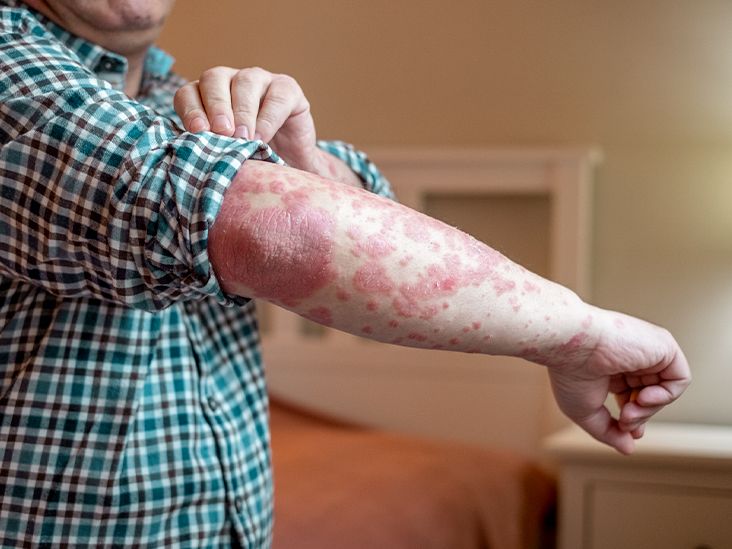A Comprehensive Guide to Auspitz Sign and Psoriasis

A Comprehensive Guide to Auspitz Sign and Psoriasis
Understanding Auspitz Sign
Psoriasis is a chronic inflammatory dermatological condition that impacts approximately 3% of adults in the U.S. This disorder commonly presents as red patches covered with silvery scales, which can develop on various body parts, including the nails.
Auspitz sign refers to the appearance of small droplets of blood that emerge when psoriasis scales are scraped off or removed. While it is most commonly associated with psoriasis, Auspitz sign can also manifest in other dermatological conditions. Effective treatment aims to prevent infections and expedite the healing process, typically utilizing a mix of topical and systemic medications. Recognizing Auspitz sign is important, as it may lead to complications, thus consulting a healthcare professional is advisable if you suspect its occurrence.
Recognizing Symptoms of Auspitz Sign
The hallmark symptom of Auspitz sign is pinpoint bleeding that occurs when scales are dislodged from a patch of affected skin. This can happen either through self-removal, incidental contact, or natural shedding. For example, if plaques form in areas like the back of the knee, their movement during bending can cause them to flake off and bleed.
The severity of affected areas may vary—some may be small while others can be larger. In certain cases, visual examination via a dermatoscope may be necessary for accurate detection.
What Leads to Bleeding in Auspitz Sign?
Auspitz sign arises when the delicate capillaries located just beneath the inflamed outer layer of the skin are exposed and ruptured during the removal of scales. This disruption leads to the characteristic bleeding.
The Role of Auspitz Sign in Psoriasis Diagnosis
Healthcare providers can often identify psoriasis through a visual assessment of the skin. Observing Auspitz sign may support a psoriasis diagnosis, but additional evaluation is typically required. Besides the visible examination, a biopsy may be performed, where a small tissue sample is extracted for laboratory analysis.
Conditions Associated with Auspitz Sign
While Auspitz sign is most frequently seen in psoriasis, other skin disorders can also exhibit this sign. Notably, actinic keratosis and Darier disease are two conditions often linked to Auspitz sign.
1. Actinic Keratosis
Actinic keratosis is more prevalent than psoriasis, affecting around 40 million individuals in the U.S. Similar to psoriasis, it presents with scaly patches, but it is also classified as a precancerous condition primarily linked to sun exposure.
2. Darier Disease
Unlike psoriasis, which features scaly plaques, Darier disease tends to exhibit wart-like, yellowish patches that may be greasy and have a notable odor.
Treating Auspitz Sign
The treatment for Auspitz sign focuses on healing the affected skin while preventing any risk of infection. Dermatologists often prescribe topical antibiotics along with recommendations for gentle cleansing and protection of the bleeding areas to facilitate recovery.
Specific treatments may vary depending on the underlying condition associated with Auspitz sign. Common treatment options across different conditions may include the use of topical retinoids, which encourage skin cell turnover.
Psoriasis Treatment
For psoriasis, management may involve topical corticosteroids to mitigate inflammation, and/or immunosuppressive medications to modulate immune response. Moisturizers can also be beneficial in keeping the affected areas hydrated, reducing the chances of complications from Auspitz sign.
Actinic Keratosis Treatment
Treatment for actinic keratosis often includes procedures aimed at removing abnormal skin growths. Commonly utilized methods may encompass:
- Cryotherapy
- Laser therapy
- Chemical peels
- Photodynamic therapy
- Curettage (surgical scraping)
- Surgical removal
Sometimes, topical medications such as 5-fluorouracil may be prescribed, targeting rapidly dividing cells.
Darier Disease Treatment
For managing Darier disease, dermatologists may prescribe a combination of topical corticosteroids and benzoyl peroxide. Oral antibiotics and immunosuppressants like cyclosporine may also be utilized. In some instances, Vitamin C supplements may be advisable.
When to Seek Medical Attention
If you have psoriasis or any skin condition and observe bleeding when scales are removed, it's crucial to consult a healthcare provider promptly. While Auspitz sign itself isn’t immediately dangerous, it heightens the risk of infection. Early intervention ensures that the appropriate treatment can commence swiftly, minimizing potential complications.
Conclusion
Auspitz sign is an essential indicator within the context of psoriasis, as it signifies the vulnerability of capillaries during flare-ups. Partnering with a qualified dermatologist or healthcare professional can significantly enhance the management of your skin health. Identifying Auspitz sign can provide valuable insight into underlying conditions, paving the way for timely interventions.
